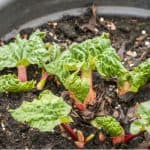Last updated on March 23rd, 2022
Our site is reader supported, this means we may earn a small commission from Amazon and other affiliates when you buy through links on our site.
Rhubarb is a wonderful plant that requires very little of your time and maintenance. It’s incredibly strong, easy to grow, and in fact, relies upon a cold snap to produce the best yield. This makes it particularly perfect for many gardens across the UK. If you decide to grow rhubarb, with a little bit of maintenance you can make homemade rhubarb crumbles, pies and jam.
Healthy plants will produce stalks for a decade which makes it a wonderful investment. By learning a little bit ahead of time about how to maintain your rhubarb and how to care for it once you’ve planted it, you can reap the benefits for years to come.
It is important to note that a brand new, recently planted rhubarb should not be harvested the first year. So if you are expecting to get some fresh desserts the year you plant them, think again. However, if you are able to resist that temptation the first year, starting from the second year onwards you can harvest rhubarb as early as April if you grow some using a method known as forcing, which we talk about further down.
Some of our Favourite Varieties
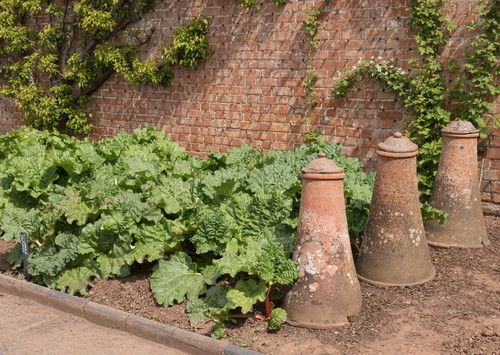
There are ample varieties of rhubarb out there and you can plant all of them in the autumn or in the spring, either as crowns or as potted plants available from garden centres, nurseries and even online. Below are some of the best options for UK Gardens:
- Champagne – This variety is good if you want to force your rhubarb. Forcing rhubarb is a process that alleviates any direct light contacting the crown so that you can get slender, pale, tasty stalks early in the year. If you don’t force this rhubarb it will produce a deep red stem.
- Thompson’s Terrifically Tasty – For very early production, this variety will give you flavoursome stalks from the middle of March all the way through summer, usually one month before any other variety.
- Victoria – Victoria is one of the most popular varieties and gives that perfect balance of sweetness and acidicity with greenish pink stems that produce very heavy yields year after year.
- Giant Grooveless Crimson – This plant gives delicate acidic flavours with bright red stems that are particularly tall. If you are planning on making jams but you don’t want an overly sweet taste because of the sugars you will add, this is the perfect variety.
- Delight – Delight will produce crops for a long amount of time and is very resistant to most diseases. The stems are red and the plant is dark green.
- Fulton’s Strawberry Surprise – This particular variety received the award for the best-flavoured rhubarb by The Royal Horticultural Society.
- Raspberry Red – As the name suggests the final production here are thick, red stalks that have a particularly sweet flavour and you don’t have to force them to get them early in the season.
How to buy Rhubarb Seeds, Crowns and Potted Plants
You can grow rhubarb from seed if you are so inclined, however, you are much better off buying budded pieces that are part of a crown, or the whole crown. The latter two will establish themselves effectively and are good for beginners.
If you get a rhubarb crown, that means the plant has been established for at least one year so the first year you plant it will technically be its second year of existence which means you can harvest the season directly after planting. So, if it’s important to be able to harvest early, invest in the whole crown, otherwise, the budded pieces can be harvested the second year after you planted them.
You can also buy plants in pots that can be planted at any time of year but they will need to be watered much more frequently.
When to Plant Rhubarb
If you purchase the budded pieces or the full crown you should plant them in the autumn or spring when they are available. This is when nurseries dig them up from rhubarb fields because they are mostly dormant. Either time of the year has warm, moist soil.
If you want to plant rhubarb at any other time of year you will have to buy potted rhubarb. These can be planted at any time of the year as long as the soil itself is not waterlogged, frozen or you are growing in pots.
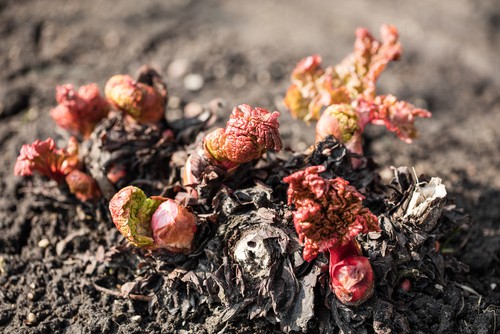
You can learn more about growing rhubarb in pots in this guide
Where to Plant Rhubarb
Rhubarb grows well if it is planted in a particularly sunny location. It needs moist, well-drained soil. The thing is, rhubarb will not respond well to any disturbance so the place you pick needs to be where it will grow without any disturbance or interruption for the extent of its life, with the exception of weeding and tidying them up in autumn and winter.
So take some time to properly figure out where in your garden you want your rhubarb to exist for the next 10 years. To sum it up, it needs fertile well-drained soil in a sunny position.
How to Plant
Once you have found the perfect spot, remove any weeds from the area and add some well-rotted manure or homemade compost into the mix. When you are ready, place your rhubarb crowns or potted planted so that the tip of the crown is just barely visible above the line of the soil.
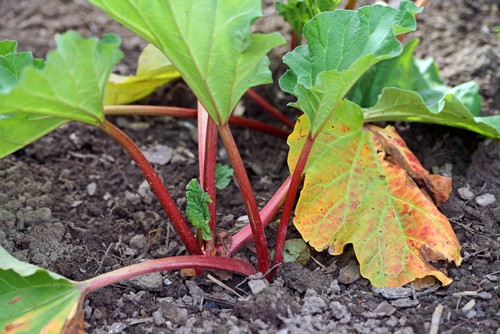
If you are growing budded pieces or crowns, the top of the crown should be about 3cm deep. If you have very heavy soil you might want to plant them a little bit nearer the surface of the soil because this will help prevent the crown from rotting. Rhubarb plants will get very big so you should space them 75-90cm apart and 30cm between rows.
Container and Pot Growing
If you don’t have an area in your garden for growing rhubarb you can always grow them in a large container. As mentioned, rhubarb gets very big, it has a very large root structure and this means any container you select should be appropriately sized and particularly deep.
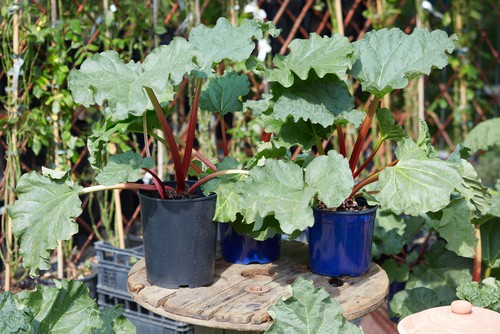
Make sure it’s at least 50cm wide and deep. Use soil-based compost, such as John Innes potting compost with well-rotted manure and mix in well. Also, add extra drainage in whatever fashion possible because they hate being waterlogged so this is very important. For example, if you have a plastic container you can always drill extra holes, whereas a ceramic container will need the addition of 5cm worth of gravel at the bottom to help improve drainage.
Read our detailed guide on how to grow rhubarb in containers by clicking here
Forcing Rhubarb to get your First Crop Early
If you want to enjoy your yield very early in the season you can force your rhubarb. To properly do this you will need to cover your rhubarb entirely. Use another large tall pot or an old container of some sort (such as a bin) and place it over the rhubarb crown. Your plant, like all other plants, needs access to sunlight in order to produce chlorophyll. Chlorophyll is what changes the colour of the plant.
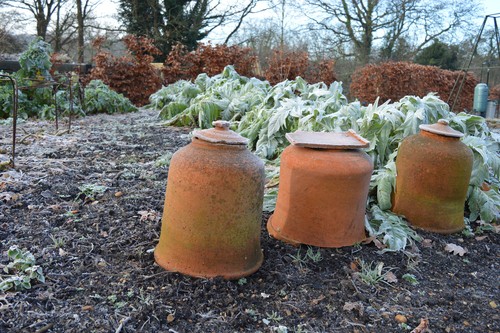
If you stunt the access the crown has to sunlight it will grow even faster in an attempt to reach the sunlight, wherever it might be. The result is that you can cut your rhubarb earlier in the season, however, be advised that a lack of chlorophyll means it will be very pale in colour, but it will still be super tasty and sweet.
Did you know you can buy purpose build rhubarb forcers? Such as the one pictured below available from Amazon.co.uk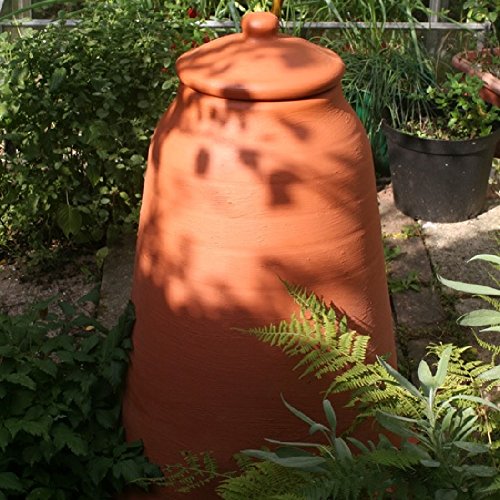
Cover the crown of the rhubarb entirely with your pot, large bucket or purpose-built rhubarb forcer. Use black masking tape to fill in any holes so that absolutely no sunlight touches the crown. Then, you should be able to harvest about 8 weeks later.
Be advised that if you force a rhubarb crown, you should not harvest it the following year, nor should you force the same crown two years in a row. This process weakens the plant substantially which is why it needs a whole season to recuperate. If you really want to force rhubarb, consider growing multiple plants so that you can stagger the process.
We have a detailed guide on forcing rhubarb which you can read by clicking here
Seasonal Maintenance
Remove any flowers and apply a general fertiliser in spring
Rhubarb is particularly low maintenance but there are some things you can do each season. In the spring you can remove the rhubarb flowers. Flowers detract from the total amount of energy your rhubarb plant can direct to the tasty stems. In the spring you can also apply a general-purpose fertiliser to help increase the growing energy the plant has.
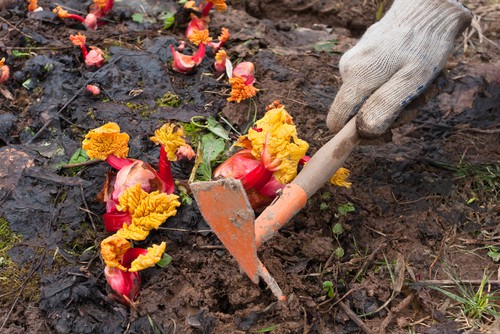
Watering
In summer be sure to water regularly when the weather is dry. If you are growing your rhubarb in containers, remember that containers dry out a lot faster than regular gardens and often need watering daily. Always try to avoid getting water on the leaves and try to water towards the base of the rhubarb plants.
Mulch in autumn with farm manure
In autumn, after the leaves have died back, you can cut back your old rhubarb so that the buds are exposed. Add some mulch, such as well-rotted manure or compost, to the crown to conserve moisture and prevent weeds.
Divide your rhubarb approximately every 5 years
In the winter, divide your rhubarb plants (every 5 years) by splitting the crown into three or four pieces and replanting them into separate areas. Simply lift the rhubarb crown and divide the crowns using a spade, sharp knife or saw. Remember not to harvest the first year after replanting the divided crowns.
Harvesting Rhubarb Stems
When you have reached your second year and you are ready to harvest, wait until the stems are around 30-40cm in length. Pull each stalk from the base of the stem and twist it off the crown, or cut near the crown with a sharp knife. You should never harvest more than half of the total number of stems on your plant because this can harm the plant and its overall productivity.
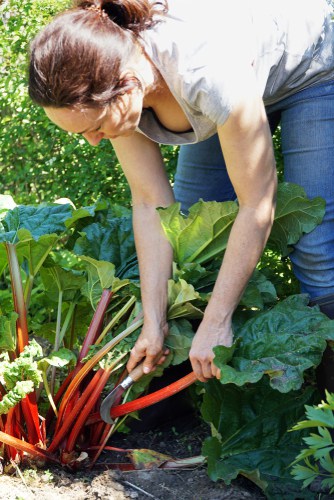
In the second year, and when you take your first crop, we recommend only removing about one third of the stems. So if you are going to use your rhubarb for desserts on a moderate to heavy basis, it’s in your best interest to grow multiple plants so that you can stagger your harvesting from all of them at the same time.
Remember, too, that only the stalks are edible. The leaves are toxic. So after you harvest, trim away all the leaves and throw them in the compost bin. Only cook with the stem.
Check out some of our recommended compost bins in this guide.
Problems
Crown rot
When growing rhubarb one of the biggest problems you might face is crown rot. Crown rot is caused by bacteria in the water, or fungi in the soil, and can spread and kill your rhubarb. It’s important that you act quickly. Once you see a problem with your plant, cut away any affected areas.
It might be in your best interest to cut ever so slightly into healthy tissue just to make sure that you have got rid of all the problems. Also, plant in well-drained soil to help prevent the crowns from rotting because they do not like to be stood in water over winter.
Slugs and snails
Keep your eyes peeled for the regular onslaught of snails and slugs, something you can prevent with a barrier of eggshells or a beer trap. Any pest problems should be dealt with immediately to prevent damage to your rhubarb.
Image credits – Shutterstock.com

